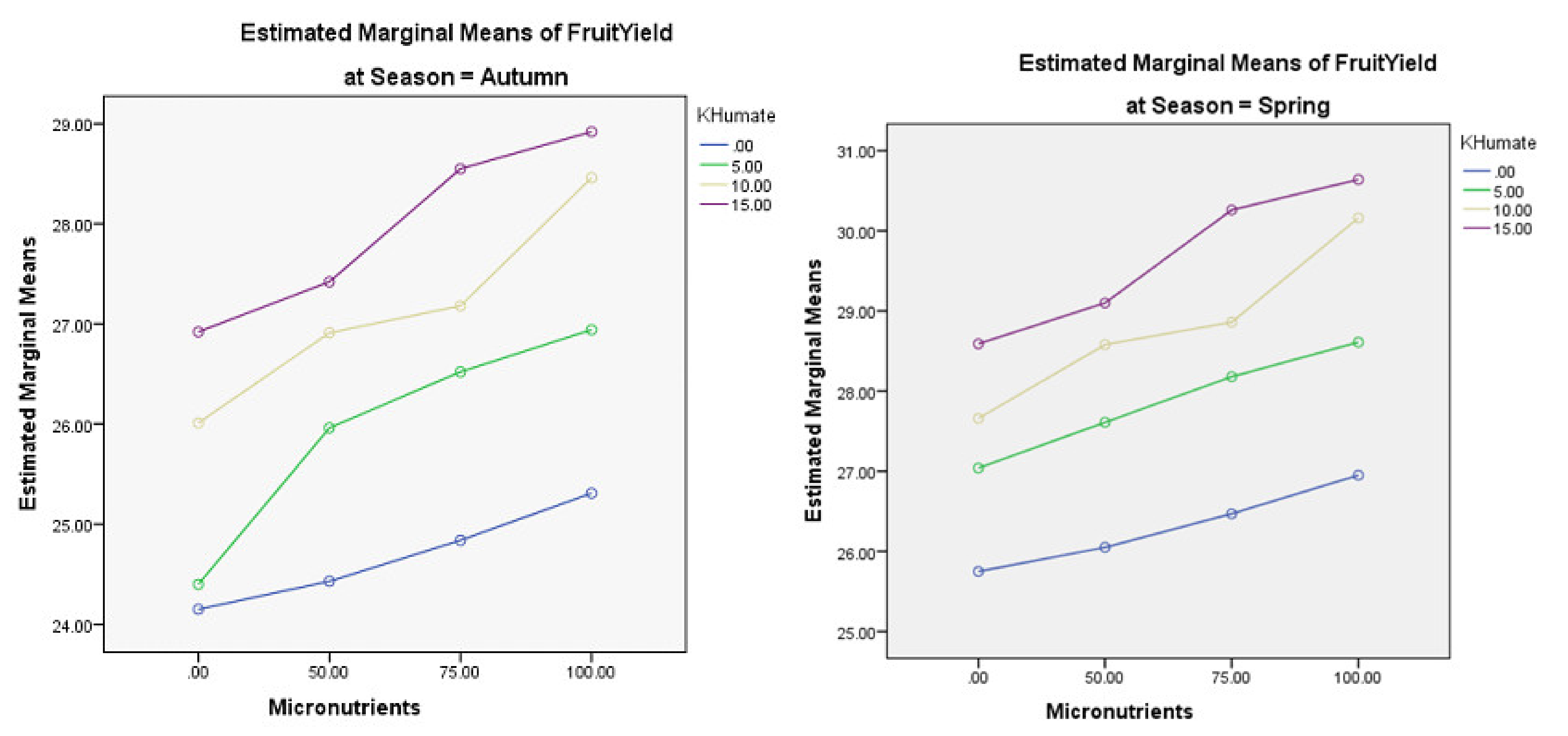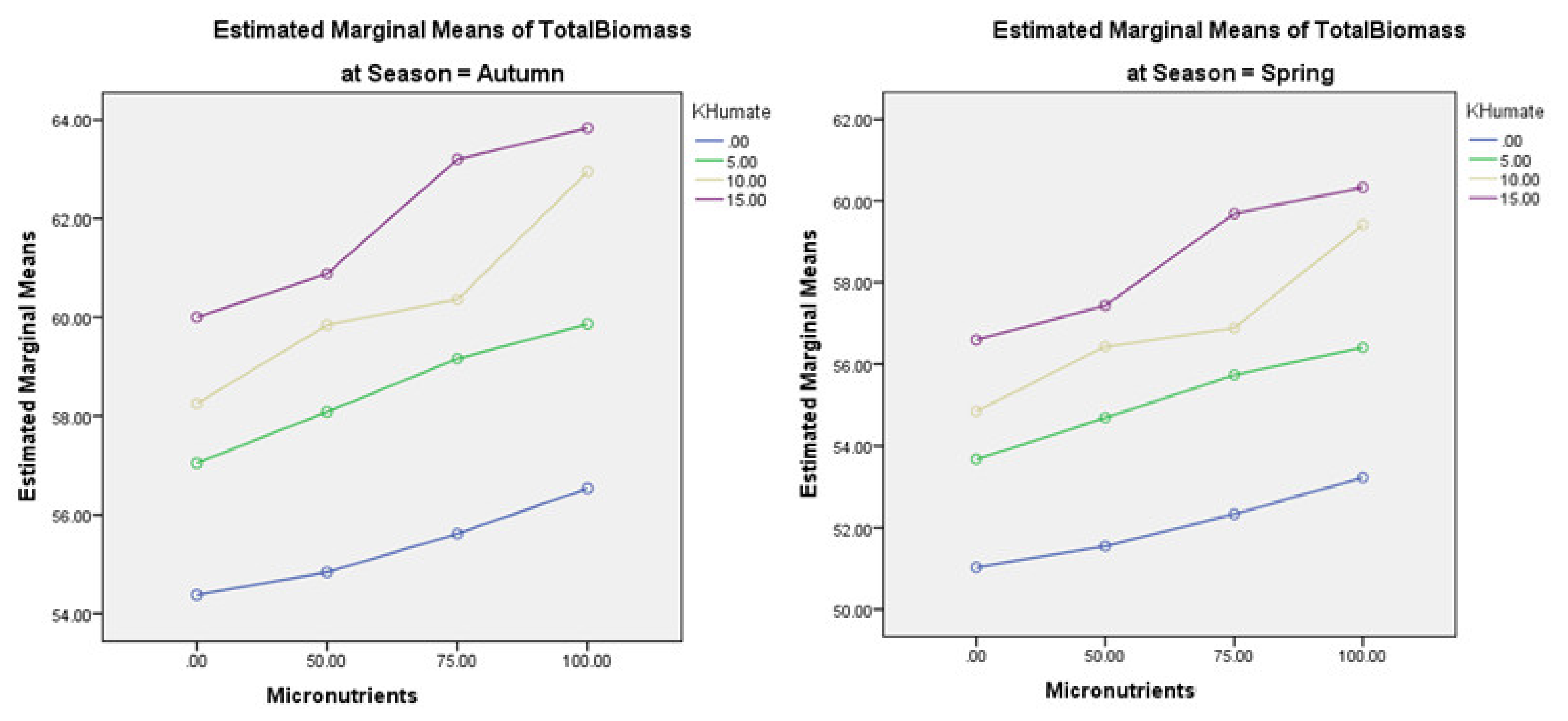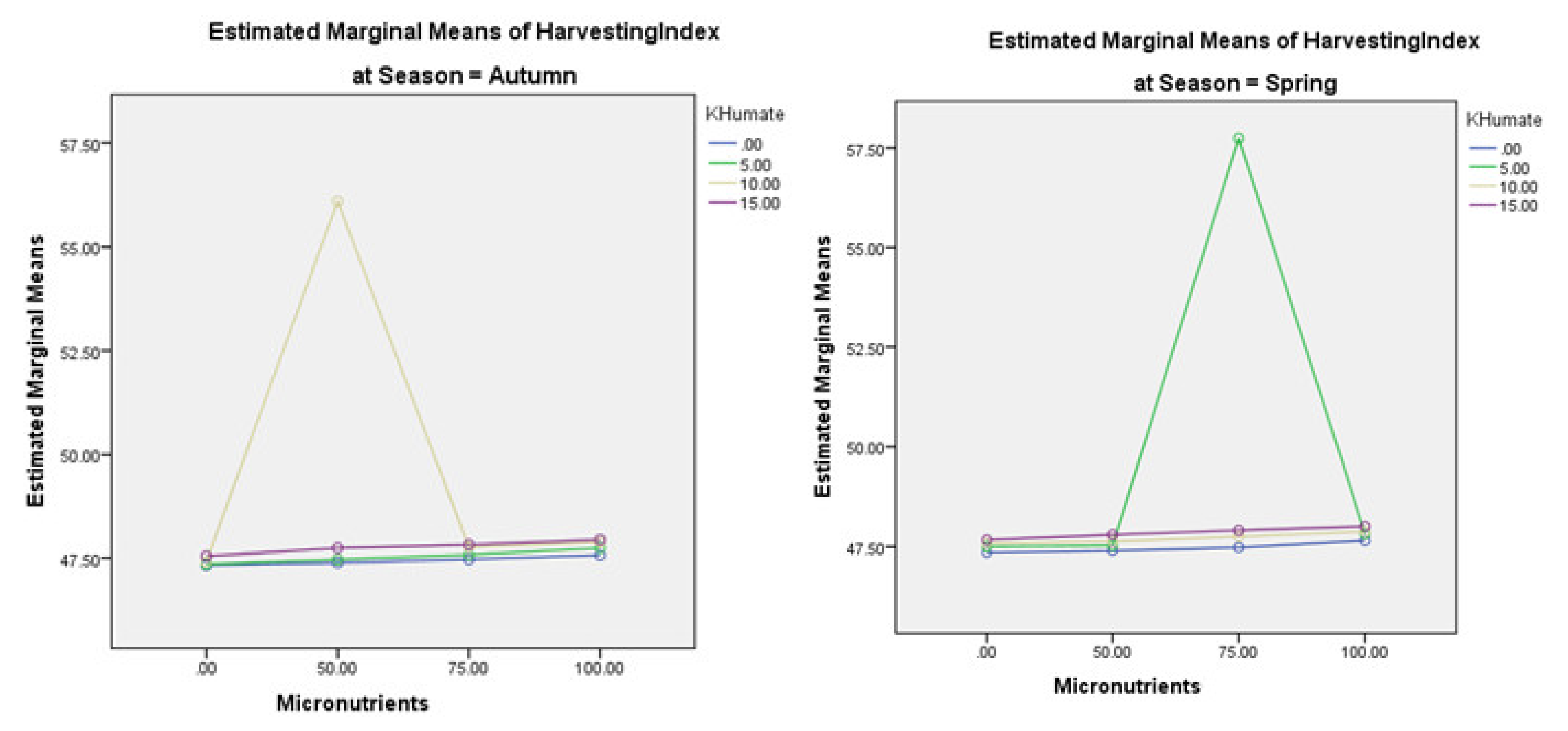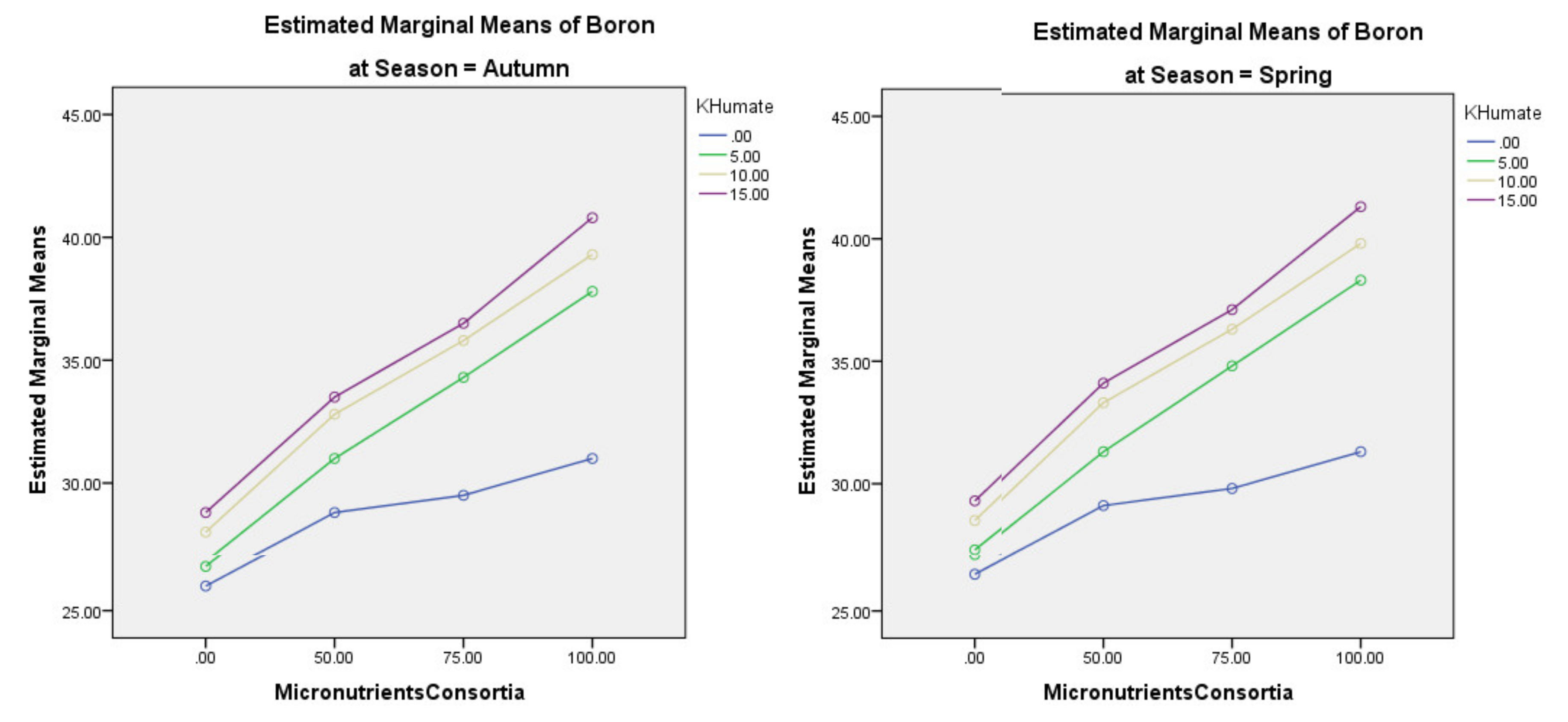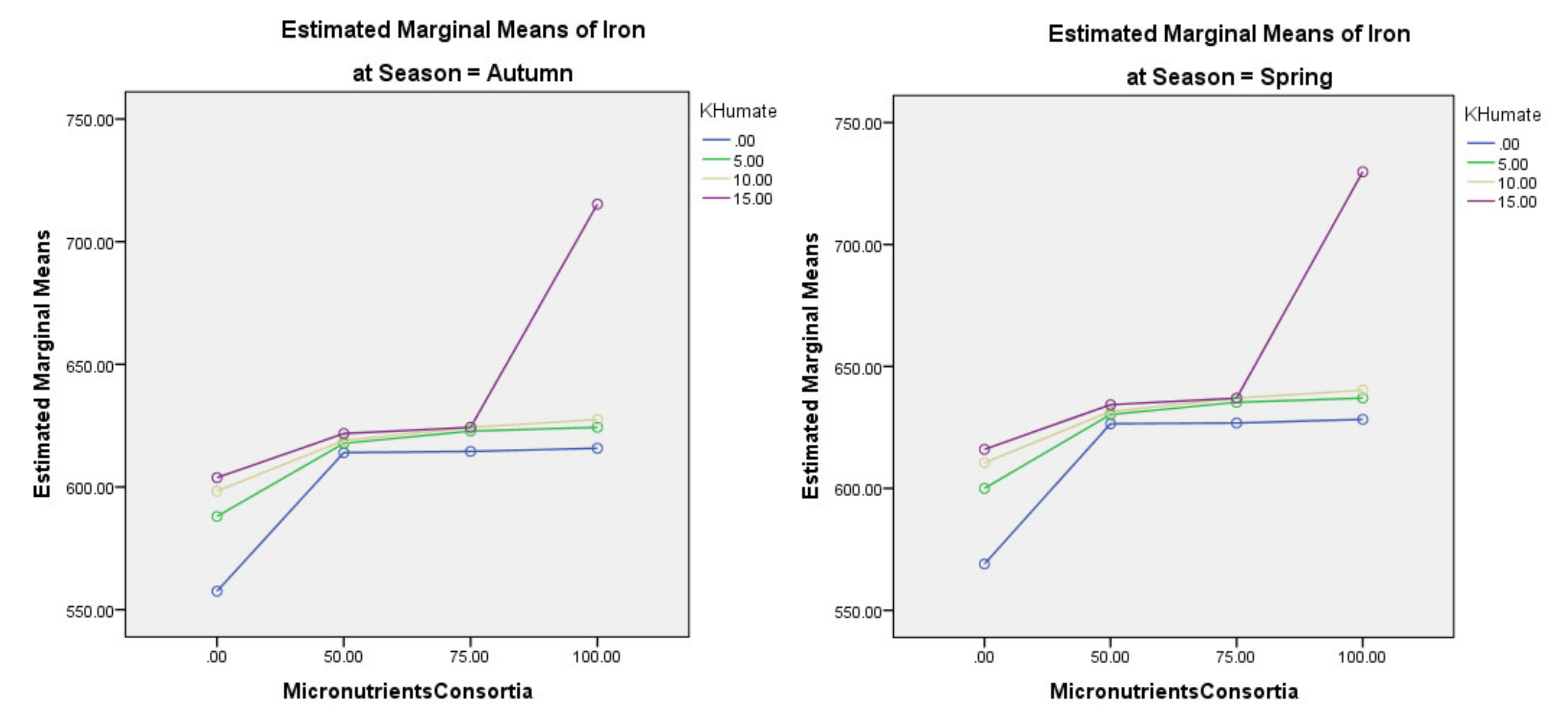1. Introduction
The loss of upper fertile soil due to intensive cropping, least micronutrients (MC) addition, heavy metals toxicity, low and no addition of organic matter (OM) is provoking problem. High temperature and less rainfall are the major causes of low OM and less microbial proliferation in the soil. In addition to the above, inorganic fertilizers and less or no organic amendments usage are also allied factors responsible for decreasing organic residues in the soil [
1]. Furthermore, deficiency of micronutrients is also becoming a big hurdle to achieve the optimum yield. These micronutrients are essential as most of the enzymatic reactions are controlled by these micronutrients. Their deficiency in plants resulted in a significant reduction of yield attributes [
2].
The soils of Pakistan are primarily alkaline, and excessive phosphatic fertilizers can cause an increased level of phosphorous concentration in the soils. Such an increase disturbs zinc’s solubility and mobility (Zn) in the soil and makes the soil Zn-deficient [
3,
4,
5]. In different micronutrients, Zinc (Zn) is an important one. It plays an imperative role in growth. Scientists have also documented that Zn is also involved in cell differentiation [
6]. Balanced Zn in the plants strengthens their immune system and provides a greater survival level to the plants [
7].
Similarly, Boron (B) is also essential for plants. Boron deficiency usually results in low transpiration, shortening of internodes, and death of plant growing point [
8,
9,
10,
11]. Furthermore, Iron (Fe) plays an imperative role in chlorophyll synthesis, cell respiration, carbohydrate manufacturing, sulphate reduction, and N assimilation [
12,
13]. However, most scientists suggest using organic amendments that are environmentally friendly to optimize the micronutrients in the crops. Among variable organic amendments, humic acids (HA) are widely found in manure, compost, peat, and sewage. Mainly HA products are manufactured from peat and lignite [
14].
Humic acids, which are oxidized forms of lignite, usually contain approximately 30–60% humic acid that makes soils more productive. These humic compounds also enhance seed germination when applied as a soil amendment at the time of sowing. The use of humic acid has also been documented as an organic fertilizer, because its application efficaciously minimizes the inorganic fertilizers’ application rates. Also, soil physical properties, i.e., soil drainage, aggregation stability, and aeration, become modified when humic acid is applied as a soil conditioner. Modification in humic compounds’ physical and chemical attributes facilitates better micronutrient availability [
12,
15].
Tomato (
Lycopersicon esculentum Mill.) ranks 3rd in production all over the world. Due to the high content of minerals, vitamins, and anti-cancerous attributes, tomato is widely consumed, either in the processed or fresh-fruit form [
16]. At the global level, tomato is cultivated at 4.5 million ha, with a yield of 124 million tons. In Pakistan,
L. esculentum per vegetable area is very low compared to other countries because of the deficiency of organic contents and micronutrients in the soils [
2]. The area under
L. esculentum cultivation is 57,000.21 hectares, providing 577,000.80 tons yield annually with an average of 10.09 tons ha
−1 yield in Pakistan [
17].
Keeping in mind the importance of MC (Zn, Fe, B) and low level of soil organic carbon in Pakistan soils, the current experiment was conducted on tomatoes. The study’s main objective was to assess the adequate level of micronutrient mixture in the presence and absence of potassium humate under variable growing seasons to improve the tomato yield, micronutrient concentration, and biomass. It is hypothesized that potassium humate (KH) with foliar MC can significantly increase the micronutrient concentration, biomass, and yield of tomatoes under variation of growing seasons (autumn and spring).
2. Material and Methodology
2.1. Research Area
A field experiment was conducted in the vegetable research area of the Department of Horticulture, Bahauddin Zakariya University, Multan. Recommended tillage operations were adopted for the preparation of seedbeds for tomato seedlings. The pre-experimental soil characteristics are provided in
Table 1.
2.2. Tomato Seedling
Tomato cv. Rio Grande seedlings (30 days old) were transplanted on beds (120 cm apart at both sides) with a 45 cm plant-to-plant distance for the achievement of 16,500 plant population ha
−1 [
26].
2.3. Macronutrients Application Rate and Time
Nitrogen, P, and K were applied at 150, 100, and 100 kg ha
−1, respectively. Urea, diammonium phosphate, and sulphate of potash were added to the soil for macronutrient application. Nitrogen was applied in 3 splits, i.e., before transplantation, flowering initiation, and peak flowering stage. P and K were broadcasted before transplantation of tomato seedlings [
27].
2.4. Micronutrients (MC) Application Rate and Time
Micronutrients were applied at the rate of 50 (Zn = 2.50, B = 0.75, Fe = 2.50 kg ha
−1), 75 (Zn = 3.75, B = 1.125, Fe = 3.75 kg ha
−1) and 100% (Zn = 5.0, B = 1.5, Fe = 5.0 kg ha
−1) [
28]. After a month of transplanting tomato nursery seedlings, a mixture of micronutrients was applied in the soil. All micronutrient doses were applied in a single split.
2.5. Potassium Humate (KH) Application Rate and Time
Based on the previous screening experiment, two application rates of potassium humate (KH), i.e., 5, 10, and 15 kg ha
−1, were chosen. Potassium humate was applied in a single dose in the soil before the transplantation of tomato seedlings [
29].
2.6. Irrigation
The first irrigation was applied just after transplanting the seedlings and continued regularly according to the requirement (65% field capacity) of the crop during the growth period.
2.7. Treatment Plan
There were 16 treatments with three replications following randomized complete block design (RCBD). The treatments were T1 = control (no Zn + Fe + B (MC) and no potassium humate (KH)), T2 = 50% MC, T3 = 75% MC, T4 = 100% MC, T5 = 5 kg ha−1 KH, T6 = 50% MC + 5 kg ha−1 KH, T7 = 75% MC + 5 kg ha−1 KH, T8 = 100% MC + 5 kg ha−1 KH, T9 = 10 kg ha−1 KH, T10 = 50% MC + 10 kg ha−1, T11 = 75% MC + 10 kg ha−1 KH, T12 = 100% MC + 10 kg ha−1 KH, T13 = 15 kg ha−1 KH, T14 = 50% MC + 15 kg ha−1, T15 = 75% MC + 15 kg ha−1 KH and T 16 = 100% MC + 15 kg ha−1 KH.
2.8. Harvesting and Analyses
Plants were harvested at the time of maturity. Fruit yield was calculated by adding the fruit weight of all harvests per unit area. Freshly picked fruits were weighed on top balance for fruit fresh weight determination. Fruits were dried at 70 °C in an oven till constant weight. After that, the weight was taken as the dry weight of fruits. An average of 10 fruits was taken per treatment. The total weight of all the fruits harvested per plant was recorded during the whole season, added to above-ground fresh plant weight and fresh root weight, and total biomass was worked out. The ratio of fruit yield to biological yield known as harvest index (HI) was obtained by following the equation given below:
For Zn and Fe in fruit analyses, digestion was made using nitric acid and perchloric acid (2:1) [
30]. Samples were digested by dry-ashing (550 °C) in a muffle furnace for determining boron. After that, ash was dissolved in 10 mL of 0.36 N H
2SO
4 and filtered using Whatman No. 42 filter paper. Finally, the Gaines and Mitchell (1979) method was used to assess B on spectrophotometer by taking absorbance at 410 nm wavelength [
31].
2.9. Statistical Analyses
Two factorial analyses of variance were used to determine the significance of treatments at p < 0.05. Interaction graphs were made on SPSS 20.0 to check the ordinal and subordinal interaction of KH and MC under the spring and autumn seasons.
3. Results
The main and interactive effects of MC and various potassium humate levels (KH) were significant for tomato yield. Application of 100% MC and 15 kg ha
−1 KH differed significantly best over control for improving the tomato yield both in the autumn and spring seasons. A similar trend was noted at 75 and 50% MC when applied in combination with 15 kg ha
−1 KH over control for improving the tomato yield both in autumn and spring. The increasing level of MC also improved the tomato yield both in autumn and spring (
Table 2). The interaction of KH and MC was significant in both the autumn and spring seasons for the tomato’s total fruit yield (
Figure 1). A maximum increase of 7.4 and 7.17% in tomato yield was observed at 100% MC and 15 kg ha
−1 KH over control in autumn and spring.
Both main and interactive effects of MC and KH were significant for the total biomass of tomatoes. Application of 100% MC and 15 kg ha
−1 KH remained significant over control for improving total biomass of tomatoes both in the autumn and spring seasons. A similar trend was noted at 75 and 50% MC combined with 15 kg ha
−1 KH over control to improve tomato’s total biomass both in autumn and spring (
Table 3). The increasing MC level also enhanced the total biomass of tomatoes both in the autumn and spring seasons. The interaction of KH and MC was significantly ordinal in the autumn and spring seasons for the tomatoes’ total biomass (
Figure 2). A maximum increase of 6.38 and 6.59% in total biomass of tomatoes was observed at 100% MC + 15 kg ha
−1 KH over control in the autumn and spring seasons.
Both the main and interactive effects of MC and KH were significant for the harvesting index. Application of 100% MC + 15 kg ha
−1 KH remained significant over control for improving the harvesting index of tomatoes both in the autumn and spring seasons. A similar trend was noted at 75 and 50% MC + 15 kg ha
−1 KH over control for an increase in tomato harvesting index during autumn and spring (
Table 4). The increasing MC level also improved the harvesting index of tomatoes both in the autumn and spring seasons. KH and MC interaction was significantly ordinal in both the autumn and spring seasons to harvest tomato (
Figure 3). A maximum increase of 0.46 and 0.76% in harvesting tomato index was observed at 100% MC + 15 kg ha
−1 KH over control in autumn and spring.
MC main effect was significant, but the main effect of KH and MC × KH remained non-significant for Zn concentration in tomatoes. Application of 100% MC performed the significantly best control for increasing Zn concentration of tomato both in the autumn and spring seasons. It was noted that 50 and 75% MC did not differ significantly for improving Zn concentration in the tomato fruit (
Table 5). However, 50 and 75% MC significantly enhanced the Zn concentration in tomato fruit both in autumn and spring. The interaction of KH and MC was non-significantly ordinal in the autumn and spring seasons for the zinc concentration in tomatoes (
Figure 4). A maximum increase of 41.3 and 41.8% in the Zn concentration of tomato was observed at 100% MC over control in the autumn and spring seasons, respectively.
MC main effect was significant, but the main effect of KH and MC × KH remained non-significant for B concentration in tomatoes. Application of 100% MC performed significantly
best over control for increasing the B concentration of tomato fruit both in the autumn and spring seasons. It was noted that 50 and 75% MC did not differ significantly for improving the B concentration in the tomato fruit during the autumn season. However, 100% MC significantly enhanced over 50% MC for the B concentration in tomato fruit during the spring season (
Table 6). No significant change was noted among 50 and 75% MC during the spring season for B concentration in the tomato fruit. The interaction of KH and MC was non-significantly ordinal in both the autumn and spring seasons for B concentration in tomatoes (
Figure 5). A maximum increase of 35.7 and 35.8% in the B concentration of tomatoes was observed at 100% MC over control in autumn and spring.
MC and KH main effects were significant, but MC × KH remained non-significant for Fe concentration in tomatoes. Application of 100% MC performed significantly higher compared to control for an increase in Fe concentration of tomatoes both in the autumn and spring seasons. Similarly, 10 and 15 kg ha
−1 KH remained statistically alike to each other but significantly higher for Fe concentration in the tomato fruit. No significant change was noted where 5 kg ha
−1 KH was applied over control for Fe concentration in the tomato fruit. It was noted that 50 and 75% MC did not differ significantly for Fe concentration improvement in the tomato fruit during the autumn season. However, 100% MC significantly enhanced the Fe concentration over 50% MC in the tomato fruit during spring (
Table 7). No significant change was noted among 50 and 75% MC during the spring season for B concentration in the tomato fruit. The interaction of KH and MC was non-significantly ordinal in both the autumn and spring seasons for B concentration in tomatoes (
Figure 6). A maximum increase of 35.7 and 35.8% in the B concentration of tomatoes was observed at 100% MC over control in autumn and spring.
4. Discussion
In this study, KH and MC significantly enhanced the yield of tomatoes. The maximum fruit yield was noted in plants where 15 kg KH ha
−1 was applied under the MC variable level. Such improvement in the yield of tomato fruit was due to high/suitable availability of micronutrients to the plants. Our finding regarding enhancement in the yield is in agreement with Moccia et al. [
32]. They observed that the application of organic amendment and MC increased the yield of cherry tomatoes.
B application increases fruit size due to the better mobilization of food material from the production sites to storage organs and causes rapid fruit development. It was noted that foliar application was significantly effective for improving the mango fruit weight [
33]. The higher yield was also associated with the greater number of flower formations due to boron absorption, and they also set a greater number of fruits [
34,
35]. Similar results were also noted in the current study, where yield per plant was enhanced due to boron and zinc application. The application of Zn also restricts the activity of dehydrogenase and proteinase enzymes. These enzymes are responsible for the fruit’s early maturity, which deteriorates the quality attributes and minimizes fruit retention [
36]. It was also noted that MC application performed significantly higher than control regarding the uptake of Zn, B, and Fe in tomato fruit.
A significant improvement in cell division and higher synthesis of proteins is also an additional benefit associated with improving the plants’ growth when potassium humate is applied as an amendment in the soil [
37,
38]. The proliferation of microorganisms by application of potassium humate in the soil is also a fact. Plant growth-promoting microorganisms use potassium humate as a rich source of energy [
39]. Improvement in the population of plant growth-promoting rhizobacteria also plays an influential role in improving crop productivity by secreting the enzymes and growth regulators [
40,
41,
42,
43,
44]. In addition to the above, the presence of potassium humate in the soil stimulates the growth of the root. Such improvement in the root elongation played an imperative role in increasing the water and nutrients uptake in the vegetable crops [
45].
On the other hand, Zn better uptake in crop plants facilitates the synthesis of carbohydrates [
46]. The application of Zn also restricts the activity of dehydrogenase and proteinase enzymes. These enzymes are responsible for the fruit’s early maturity, which deteriorates the quality attributes and minimizes fruit retention [
36]. Fe concentration was significantly better where KH was applied at the rate of 15 kg ha
−1 over control. This improvement in MC concentration might be a result of the chelation of MC by KH. The potassium humate application increases the cation exchange capacity, which improves the soil’s nutrients’ holding capacity. The higher cation exchange capacity of the soil decreases the fixation of nutrients, enhancing the bioavailability of nutrients [
47]. MC (Zn + Fe + B) significantly improved the crop yield due to B’s beneficial role in pollination, Zn in growth-promoting substances, and Fe in the electron transport chain [
48,
49].
According to Jatav et al. [
50], better development of fruit and seeds due to minimum oxidation of indole acetic acid and photosynthate translocation are positive effects of balanced B uptake in plants. Ribonucleic acid metabolism and stabilization of membrane by the balanced uptake of B played an imperative role in the sugar assimilation, resulting in the optimum yield [
51]. The higher yield was also associated with the greater number of flower formations due to boron absorption, and they also set a superior quality of fruits [
34,
35].
Sivaiahet al. [
48] applied MC as a treatment on tomatoes. They concluded that the increase in fresh-weight tomatoes was due to better uptake of nutrients. Improvement in nutrients uptake also facilitates metabolic activity and photosynthesis. Sánchez et al. [
52] observed that the combination of Fe-EDDHA, humate/amino acids, enhanced Fe uptake via modification in plant metabolism. Since humate improves plant crops, it might be uptaken by the plants when applied as an amendment [
53]. Davis et al. (2003) suggested that K and B have a synergistic effect [
54]. The application of B also enhances K and B in the plants and plays an efficacious role in growth attributes. Humate substances stimulate plant physiological processes as a result of better macro and micronutrient uptake. Better plant nutrition enhances the synthesis of vitamins, hormones, and amino acids in plants [
55].
